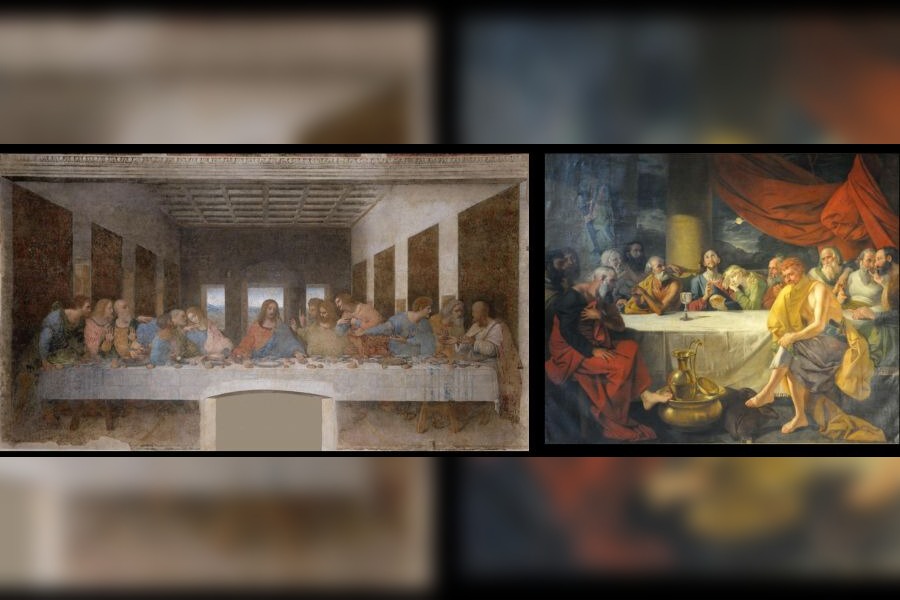Chiara Rostagno’s career highlight has been being the team leader of The Last Supper restoration project during her tenure as director of Museo Nazionale del Cenacolo Vinciano or The Last Supper Museum in Milan, Italy. These days, she devotes her time to research, talks, teaching and bringing alive the art of Leonardo da Vinci. Before flying to Calcutta — she delivered three talks here — Rostagno was in Delhi, where she addressed audiences at the Kiran Nadar Museum.
The heritage architect talks about da Vinci like a student would of her master, and when she talks about The Last Supper, she seems to exude a certain spirituality. It feels as if she is talking in a trance.
Rostagno insists, though, that while it is a religious painting — the tragic scene of the betrayal of Christ — she has come to think of it as more human than religious. “It shows the moment in which a man understood he was being betrayed. That is not so Christian.”
The story goes that when da Vinci moved from Florence to Milan in 1480, he introduced himself to the duke as a good military engineer, good at sculpture and able
to do a bit of painting. It was not until a few years had passed that the duke asked him to paint.
“Very few pieces can change the course of art history and The Last Supper is one of them,” says Rostagno. She continues, “He spent almost a decade on it. Four years painting it in the refectory of the Convent of Santa Maria Delle Grazie, plus the sketching, which he started in the 15th century.”
As she sees it, the painting expresses da Vinci’s knowledge of the human soul. “When I look at it, I can understand how I feel when I think I am being betrayed. It speaks a kind of universal language. Leonardo da Vinci was able to do that, as he was able to do it with Mona Lisa,” she says.
At the time of this inter- view, Rostagno has only heard of Calcutta’s The Last Supper, the one by Johann Zoffany from 1787 and on display at St. John’s Church. She is yet to see it.
The German neo-classical painter’s work had created a lot of controversy, especially with his depiction of St. John and Judas Iscariot. Zoffany’s St. John is a feminine figure to the left of Christ, apparently modelled after W.C. Blacquerie, Calcutta’s first police magistrate. Judas was painted after auctioneer William Tulloh with whom the painter had fallen out.
Rostagno says, “It’s very important to have real people in a painting. That works like a strong connection between the people and the painting.”
The conversation turns quite naturally to Renaissance humanism. Rostagno says, “Humanism was at the centre of the Italian Renaissance, men and women were in the middle of the compositions. Today, I feel the need for another Renaissance. We are just out of Covid-19 and in the middle of wars. In Italy, we feel very close to the ongoing wars with Ukraine, Russia, Israel and Palestine. We are waiting for a new Renaissance, we are waiting for a new humanist to put people out of this immense misery.” She firmly believes that art and culture can help people at such a juncture.
Talking about heritage and protecting it from the manmade ravages of war, Rostagno points out that The Last Supper was bombed twice. “Heritage is an expression of people and so warmongers try to des-
troy people by destroying their heritage and their existence... When you see the Sala Delle Cariatidi at the Royal Palace in Milan, you can
see the marks of bombing.
So we left the marks of the war for people to understand the violence of war.”
A community must protect its art heritage not just from war but also from the unthinking ways of day-to-day life, pollution for instance. Rostagno says, “For example, choose to walk, have pedestrian areas close to museums and monuments. That is the approach we have in Italy. When I was director of The Last Supper Museum, I asked the municipality to stop transport
services... It must be a kind of common goal to take care of heritage.”
And for the paintings in particular, there must be a good heating, ventilation and air conditioning (HVAC) system in place to control air purity. The HVAC system of da Vinci’s The Last Supper has eight metres of filters.
Before she leaves the city, Rostagno makes sure to stop by St. John’s Church to see Zoffany’s work. Thereafter she tells The Telegraph, “The painting moves me. It shows how it is about all the people who give strength to the pictorial composition. Emotion, movement, space and light form the true language of art. Putting the people who will later experience it at the centre of the painting is a choice that breaks the painted canvas and merges it with life.”










